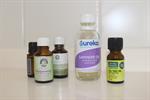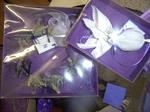
Add Aromatherapy to your Healing Methods
- Develop a basic understanding of the safe use of Aromatherapy oils, and their production.
- Discover what herbs are used, and how they are grown for oil production
- Learn how oils are extracted and mixed with carriers to create aromatherapy product
- Build your capacity to start a business or working with aromatherapy oils
One of our Aromatherapy students said about the course:
"This course was very interesting, challenging and very worthwhile" N. Mills
Lesson Structure
There are 8 lessons in this course:
-
Plant Identification
-
Importance of Correct Plant Identification
-
Plant Name Changes
-
Common Names
-
Scientific Names
-
Levels of Classification in Plant Taxonomic System
-
Plant Families
-
Pronunciation of Plant Names
-
Introduction to Chemistry of Herb Plants
-
Parts of a Compound; Biochemical Groups, Chemical Names
-
What is an Acid or Base
-
Alkaloids
-
Tannins
-
Introduction to Aromatherapy
-
Origins of Aromatherapy
-
Top Notes, Middle Notes
-
Aromatherapy Consultations
-
Natural Chemicals in Plants
-
Saponins; Phenolglycosides; Anthraglycosides; Flavonoids; Mustard Oils; Polysaccharides; Prussic Acid; Glycosides; Coumarin; Essential Minerals, etc
-
Resources
-
Essential Oils
-
Introduction
-
Benzoin
-
Bergamot
-
Cedar Wood
-
Chamomile
-
Clary Sage
-
Eucalyptus
-
Frankincense
-
Geranium
-
Juniper
-
Lemon
-
Lavender
-
Marjoram
-
Orange
-
Peppermint
-
Rose Otto
-
Rosemary
-
Sandalwood
-
Tea Tree
-
Thyme
-
Ylang Ylang
-
Australian Bush Flower Remedies
-
Safe Use of Essential Oils
-
How Essential Oils Work
-
Inhalation
-
Absorption
-
Quantities to Use: Recommended rate, oil type, smell
-
Blending Oils
-
Children
-
During Pregnancy
-
For Animals
-
Carriers
-
Using Carriers
-
Sweet Almond Oil
-
Apricot Kernal Oil
-
Avocado Oil
-
Canola Oil
-
Burners
-
Inhalation
-
Spray, Basin, Hands, Bath
-
Carrier Oils, Creams and Lotions
-
Growing and Harvesting Herbs for Essential Oil
-
Herb Cultivation
-
Harvesting different plant parts
-
Harvesting different types of Herbs
-
Expected Yeilds for Different Herbs
-
Harvesting for Essential Oils; Tea Tree, Lavender
-
Post Harvest Handling of Herbs; temperature, moisture loss, physical damage ethylene, pathogens
-
Post Harvest Preservation: Fresh, Modified Atmosphere Packaging
-
Methods of Extraction
-
Introduction
-
Water Distillation
-
Steam Distillation
-
Maceration
-
Effleurage
-
Expression
-
Fixatives
-
Herbal Preparations
-
Preparing Teas, Rinses and Baths
-
Preparations using different herbs
-
Decoction
-
Hazardous Herbs and Oils
-
Introduction
-
Carcinogens
-
Photosensitisers
-
Allergens
-
Hormone Like Affects
-
Teratogens
-
Cellular Respiratory Inhibitors
-
Cathartics
-
Abortifacients and Irritants
-
Alkaloids; types
-
Toxic Amino Acids
-
Glycocides
-
Terpenes
-
Plant Acids
-
Poly-ynes
-
Furanocoumarins
-
Proteins
Aims
-
Undertake brief written report on what you understand about how plants are named
-
Give the scientific names of ten different plants from which essential oils are derived.
-
Give a brief summary of your knowledge of aromatherapy and essential oils.
-
Understand how herbs are promoted to the public in order to sell them.
-
Write an essay on the history of aromatherapy and essential oil use.
-
Suggest different blends that can be used for insomnia and other complaints
-
Suggest different blends that can be used for treating a head cold.
-
Discuss a range of oils that would be suitable for a travel kit
-
Understand the use of aromatherapy for children.- List a range of oils that would be considered safe to use for children.
-
Write a short essay on ways in which essential oils can be used.
-
Understand the use of essential oils on animals.
-
List a range of types of vegetable oils appropriate for use in massage and indicate what types of skin the oils are good for.
-
Explain how oils enter the body and how a carrier will assist with this entry.
-
Submit the bath oil blends from a Set Task along with instructions on how to use them in the bath and what conditions they are good for.
-
Understand why some herbs tend to be collected in the morning, some before flowering, some during flowering, and others at various times of the year. What impact does this have on the essential oil?
-
From catalogues collected, explain why some oils cost more others.
-
Discuss different methods of oil extraction and list their benefits and disadvantages.
-
Comprehend what is the difference between an essential oil and an aromatic oil
-
Compile a detailed costing for processing herb materials to produce essential oils.
-
List a range of essential oils that are not safe for use in aromatherapy.
-
Discuss how essential oils can be used safely and ways in which they should not be used.
-
Understand which essential oils may not be safe for use during pregnancy.
It all Starts with Accurate Plant Knowledge
 Knowing the botanical names of plants and how they are derived is an important part of Aromatherapy. Most people know essential oils by their common names, such as Lavender, Thyme or Eucalyptus. However, unless you are aware of the botanical names, you cannot be sure of the source of the oil you are using.
Knowing the botanical names of plants and how they are derived is an important part of Aromatherapy. Most people know essential oils by their common names, such as Lavender, Thyme or Eucalyptus. However, unless you are aware of the botanical names, you cannot be sure of the source of the oil you are using.
For instance, there are several different types of plant that are commonly known as Lavender, and more than one of these plants are used to produce lavender oil. Oil distilled from True Lavender, or Lavandula angustifolia, is the highest quality lavender oil. However, lavender can also be distilled from Lavandula x intermedia and Lavandula latifolia. All three smell very similar, and can even be confusing for an experienced aromatherapist, but the chemical composition of Lavandula angustifolia is far superior to that of Lavendula x intermedia and Lavadula latifolia and is a much better therapeutic oil.
A reputable supplier will differentiate between the types in both the common name and the botanical name listed on the bottle, using Lavender for Lavandula angustifolia, Lavandin for Lavandula x intermedia and Spike Lavender for Lavandula latifolia. Some suppliers, however, will use the label Lavender for all types, and while not exactly dishonest, it is inaccurate. As a result, unless you are able to identify the oil by the botanical name, which should always be listed on the label, you can't be sure of what you are buying.
Another example is with Thyme. Sweet Thyme, Thymus vulgaris geraniol, is a relatively safe oil that can be used for colds and congestion. Red Thyme, Thymus vulgaris thymol, is a very powerful herb and should only be used under the guidance of a trained aromatherapist. But, as many suppliers sell the oil as Thyme, it can be difficult to know what you are getting, unless you can identify the botanical name.
WHO IS THIS COURSE FOR?
- Anyone who wants to develop a deeper and more serious understanding of aromatherapy
- Herb growers, herb manufacturers or herb traders
- Crafts people - candle makers, soap makers, etc
- Herb farmers, nurserymen, gardeners and landscapers
